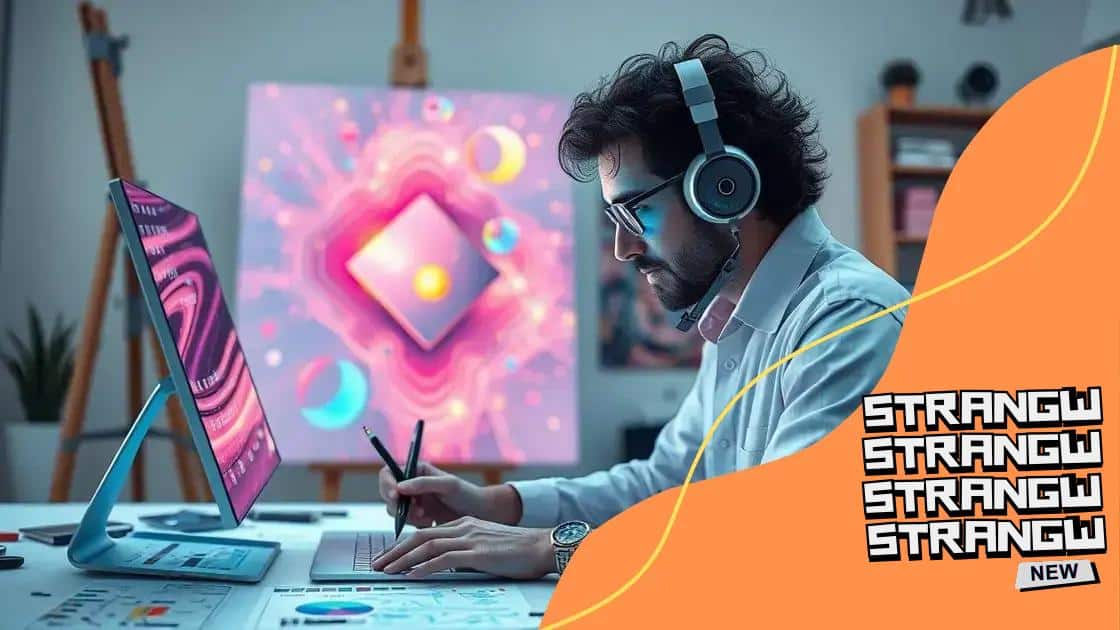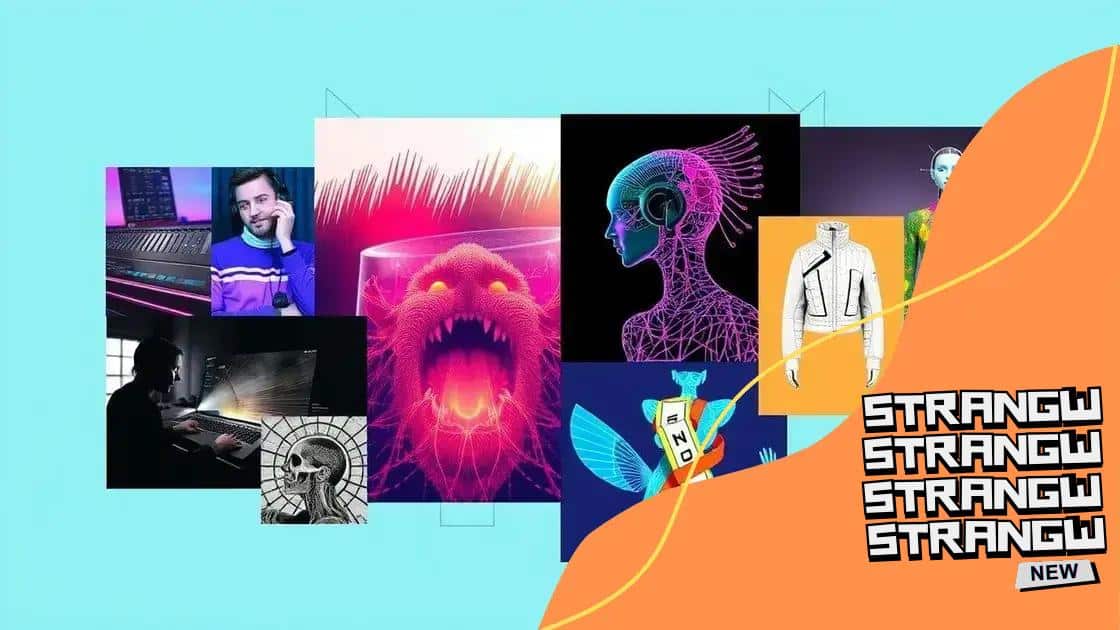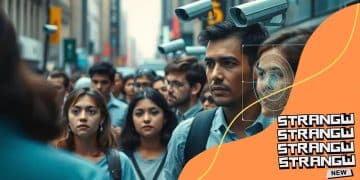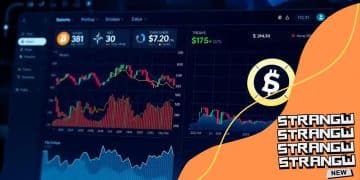The role of AI in transforming the creative industries

The role of AI in transforming the creative industries includes enhancing artistic expression, personalizing experiences, and revolutionizing traditional practices while posing challenges such as ethical concerns and market competition.
The role of AI in transforming the creative industries is opening new avenues for artists and creators. Have you ever wondered how technology influences art? This article delves into that fascinating intersection.
Understanding AI’s impact on creativity
Understanding AI’s impact on creativity is vital in today’s digital landscape. As artificial intelligence evolves, its influence on the arts and creative industries grows stronger. Artistic expression can now merge with technology like never before.
How AI is Shaping Creative Processes
AI tools are transforming the way artists create. By providing new resources and techniques, they enhance creativity and widen possibilities. For instance, AI-driven software can help isolate colors, suggest patterns, or even generate entire compositions based on user input.
Benefits of Integrating AI in Creativity
Many creators have begun to explore AI’s benefits:
- Increased efficiency by automating repetitive tasks.
- New forms of expression that challenge traditional methods.
- Access to vast datasets for inspiration and learning.
- Collaboration opportunities with AI as a creative partner.
This shift not only enhances individual creative output but also fuels innovation across various fields. Artists can push boundaries, creating works previously thought impossible.
However, it’s essential to consider the balance between human intuition and machine capability. While AI can analyze styles and trends, the human touch remains irreplaceable. The question arises: can creativity still be authentic if influenced heavily by algorithms? This ongoing dialogue is part of what makes the intersection of AI and creativity so fascinating.
Exploring Real-World Examples
Several renowned case studies highlight how artists use AI:
- Musicians using AI to compose new melodies.
- Visual artists generating unique pieces through neural networks.
- Writers employing AI tools for brainstorming and editing.
These examples demonstrate the practical applications of AI, showcasing its rapid acceptance in creative fields. As the line between creator and technology blurs, the future promises even more exciting developments.
How AI tools enhance artistic expression
How AI tools enhance artistic expression is a crucial topic in the world of creativity. These tools empower artists by providing innovative methods to expand their creative horizons. With the right technology, artists can experiment, create, and ultimately express themselves in ways that were previously unimaginable.
AI-Assisted Creativity
One significant way AI enhances artistic expression is through tools that assist in the creative process. For instance, AI algorithms can analyze vast amounts of data and suggest new ideas or even complete projects based on user input. This collaboration allows artists to focus more on their vision while AI handles repetitive tasks. Artists can seamlessly integrate their styles with AI-generated components.
Inventive Tools for Artists
A range of AI tools caters specifically to various types of artists:
- Music Generation Software: AI can compose original music tracks based on given parameters and styles.
- Visual Art Generators: Tools can create striking images and graphics using neural networks trained on thousands of examples.
- Writing Assistants: AI can help writers brainstorm, edit, and structure their work effectively.
- Interactive Installations: These tools use AI to change based on viewer interactions, creating unique experiences.
Such variety enriches the creative toolkit, allowing for a personalized approach to artistic expression. In essence, these tools don’t replace creativity; instead, they provide new avenues for exploration and expression.
Exploring further, collaborations with AI can lead to unexpected results. Many artists find joy in the surprises that AI-generated outcomes can bring. The unpredictability can lead to innovative directions that spark new ideas and projects. This synergy promotes experimentation and pushes the boundaries of traditional artistic practices.
Real-Time Feedback
Another benefit includes real-time feedback from AI tools. Artists can get instant critiques or suggestions, facilitating a faster iterative process. This feature encourages constant improvement and adaptation of their work.
With AI tools, artists are given a powerful ally in their creative journey. As these tools become more advanced and accessible, the possibilities for artistic expression will grow exponentially. It’s exciting to think about the new forms of art that will emerge as a result. Artists can harness this technology to challenge norms and redefine what creativity means in the modern age.
Successful examples of AI in the creative sector

Successful examples of AI in the creative sector showcase how technology is reshaping traditional artistic practices. Various industries have embraced AI, leading to innovative works that blend creativity with advanced technology.
Music Industry Innovations
In the music industry, AI has revolutionized how songs are composed and produced. For example, Amper Music allows musicians to create custom tracks by setting parameters like mood, genre, and tempo. This tool is perfect for artists looking to quickly generate ideas.
Visual Arts and AI
Visual artists are also using AI tools to enhance their creations. DeepArt, for instance, employs deep learning algorithms to transform photos into artwork reminiscent of famous styles. Artists can experiment without traditional limits, exploring endless possibilities.
- AI Portraits: Platforms like GANPaint Studio let artists create surreal portraits, offering a unique blend of human creativity and AI generation.
- Art Generation: Tools such as Daz 3D allow for the creation of 3D scenes and models that artists can adapt and build upon.
- Film and Animation: AI tools assist in storyboarding, character design, and even script generation, making the film-making process more efficient.
These applications highlight the potential of AI not only as a tool but as a creative partner. The collaboration between artists and machines leads to groundbreaking works across media.
Fashion Industry Transformation
The fashion industry has not been left behind. Brands like Stitch Fix use AI algorithms to predict trends and personalize shopping experiences. By analyzing customer preferences, these platforms create curated selections that match individual styles.
Additionally, AI can assist designers in creating innovative fabrics or predicting future fashion trends by analyzing vast amounts of data. This integration opens up new avenues for creativity, allowing designers to focus more on artistry rather than solely on market research.
Writing and Content Creation
In the realm of literature and content creation, AI is making waves. Programs like OpenAI’s GPT-3 provide tools that can generate human-like text, which writers can use for inspiration or editing assistance. Authors are exploring ways to incorporate AI-generated ideas into their narratives, enriching their storytelling process.
Overall, these successful examples of AI integration in the creative sector underline the transformative power of technology. As artists continue to explore the avenues opened by AI, creativity will evolve, challenging what we define as art and creativity.
Challenges faced by artists using AI
Challenges faced by artists using AI are becoming more evident as technology integrates more into creative processes. While AI presents numerous opportunities, it also brings a set of unique hurdles that artists must navigate. Understanding these challenges is crucial for leveraging AI in a way that complements human creativity.
Loss of Authenticity
One major concern is the potential loss of authenticity in art. Artists often fear that relying on AI could dilute their personal style or voice. The question arises: how much of the creation remains truly theirs? This dilemma can discourage some from embracing AI fully.
Technical Skills Barrier
AI tools often require technical knowledge that not all artists possess. Learning to use complex software can be time-consuming and frustrating. Artists may feel overwhelmed by the need to blend their creative skills with technological proficiency. This gap between creativity and tech skills can limit access to the benefits AI can offer.
- Learning Curve: Adapting to new tools takes time and patience.
- Cost of Acquisition: Many AI tools come with high costs that can be prohibitive for individual artists.
- Over-reliance on Technology: There’s a risk of becoming too dependent on AI, leading to a decline in traditional skills.
Another challenge involves the ethical implications of using AI. Artists face questions regarding copyright and originality. If an AI generates a piece of art based on existing works, who owns the final product? Understanding the legal landscape around AI-generated art can be complex and daunting.
Market Competition
As AI tools become more accessible, the market becomes saturated with AI-generated works. This influx can make it harder for individual artists to compete, as potential buyers might gravitate towards less expensive AI-created content. The question of value arises—how do we determine the worth of human-created art versus AI-generated pieces?
Artists must carve out their niche, emphasizing their unique perspective and skills. While AI can enhance creativity, standing out in a crowded marketplace presents ongoing challenges. These factors combined can inhibit artists from fully exploring the potential of AI in their work.
The future of creativity with AI involvement
The future of creativity with AI involvement looks promising and exciting. As technology continues to evolve, the role of AI in the creative process will expand, leading to new forms of artistic expression. Artists are beginning to realize the potential of AI as a powerful collaborator.
New Avenues for Creation
AI will help artists explore uncharted territories. By utilizing AI tools, creators can generate unique ideas and concepts that challenge traditional boundaries. This collaboration could lead to entirely new genres and styles of art. For instance, artists might use AI to blend different art forms seamlessly, creating immersive experiences that engage audiences like never before.
Personalized Artistic Experiences
In the near future, AI will enhance the personalization of art and creative content. Imagine an app that tailors music or visual art to an individual’s preferences based on their mood or past experiences. This level of personalization will revolutionize how people interact with art, making it more accessible and engaging.
- Augmented Reality: Integration of AR with AI will enable interactive art installations that respond to viewer movements.
- AI-Driven Storytelling: Writers will leverage AI to create dynamic narratives that change based on reader choices.
- Collaborative Platforms: Artists and AI will work together on online platforms to co-create art in real time.
As AI technology advances, it is likely to become more intuitive and user-friendly. This means that even those with limited technical skills will be able to harness AI effectively in their creative endeavors. Breaking down these barriers will invite a larger pool of artists to experiment and innovate.
Ethical Considerations
However, with these advancements come important ethical considerations. Artists and technologists will need to address questions about authorship and originality. As AI generates more creative works, it will be essential to consider how to respect and attribute intellectual property.
Collaboration between creatives and AI will likely result in a new artistic landscape. Artists will not only be creators but also curators of technology, choosing how to integrate AI in their work. This synergy will enhance creativity, pushing the boundaries of what we understand as art.
FAQ – Questions about the role of AI in transforming the creative industries
How can AI enhance artistic creativity?
AI provides new tools and methods for artists, allowing them to explore innovative ideas and push the boundaries of traditional art forms.
What are the ethical concerns regarding AI in art?
Ethical concerns include questions about authorship, originality, and the potential loss of authenticity in artistic expressions.
How does AI personalize artistic experiences?
AI can analyze user preferences and create tailored art experiences, ensuring that the content resonates with individual audiences.
What challenges do artists face when using AI?
Artists may struggle with technical skills, concerns about authenticity, and the market competition with AI-generated works.





